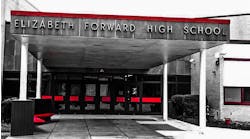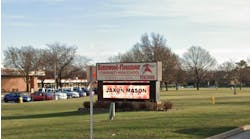The threat of school violence was well-known to educators, but until the tragic massacre at Columbine High School in 1999, many administrators did not address the threat seriously.
Likewise, most college and university administrators were aware of the safety risks that exist on their campuses, but it took the January 2000 deaths of three students in a residence-hall fire at Seton Hall University in South Orange, N.J., for officials to focus on the lack of sprinkler systems in many student-housing facilities.
“The Seton Hall fire got a lot of attention nationwide,” says Alan Sactor, fire-safety manager at the University of Maryland in College Park.
Many fire-prevention techniques help make a campus safer: having enough fire and smoke detectors; educating and training students and staff about fire safety; designing facilities so that people can exit quickly and easily from a building; and using fire-resistant equipment and materials.
Most of those steps make it less likely that a fire will occur. But fires still can happen, and when they do, sprinkler systems can keep a minor incident from becoming a major tragedy.
“Ultimately, student-housing administrators need to seriously consider the installation of automatic sprinkler systems in the residential facilities they manage,” says Frederick Mowrer, associate professor in the department of fire protection at the University of Maryland.
In a report, “Fire-Safe Student Housing: A Guide for Campus Housing Administrators,” Mowrer says sprinkler systems “have an established record of preventing catastrophic fires in residential facilities, making sprinkler protection perhaps the single most effective weapon in the residential building fire-safety arsenal.”
Recognizing risk
A fire can occur in any building on campus, but because of the specific risks residence halls pose, college officials focus their attention there.
“In a building where people are not sleeping, they can respond to an alarm,” says Sactor. “In a dorm, not everyone may hear it.”
Students living in a residence hall may be living away from their parents for the first time, and often test the boundaries. Some experiment with smoking or drinking for the first time. They may be ignorant or dismissive of the need for fire safety. Students may disable alarms, use electrical appliances improperly or overload electrical connections. In some cases, fire alarms are pulled so often in residence halls that students no longer pay attention to them or take them seriously.
Colleges and universities can combat these fire risks in a number of ways.
“We do extensive training,” says Dennis Mueting, fire marshal for the University of California at Berkeley. “We have mandatory fire drills and have training sessions for the resident assistants.”
Fireproof doors, windows and furniture; sufficient numbers of smoke and fire alarms; and stairways and corridors of adequate width also can diminish the chances of a fire.
“You have to make sure that people can get out,” says Sactor.
Local and state fire codes ensure that many of those fire-prevention steps are included in a building.
But prevention strategies can only do so much. Studies show that the leading cause of fires in student housing is arson. When a person is intent on starting a fire, a sprinkler system that can extinguish the flames becomes the best line of defense.
Retrofitting
For new residence halls, fire codes typically require sprinkler systems. But on most campuses, student housing was built before sprinklers became a requirement.
Many schools, as they renovate their residence halls, are installing sprinklers.
“We're doing seismic upgrades, and as we do those, we are retrofitting those buildings with sprinklers,” says Mueting.
The University of Maryland is spending about $11 million to put sprinklers into eight residence halls, says Sactor.
Some colleges and universities have argued that retrofitting buildings with sprinklers would be too costly, but sprinkler proponents say that installing sprinklers could recoup their investment through reduced insurance costs.
In New Jersey, after the fire at Seton Hall, cost didn't stand in the way of mandating sprinkler systems. Spurred by the tragedy that killed three and injured more than 50, the state quickly passed legislation requiring automatic sprinkler systems in every residence-hall room in public and private colleges, universities and boarding schools.
Several months after the fire, all residence halls at Seton Hall were equipped with sprinklers.
Beyond the campus
Even if colleges and universities were able to install fire sprinklers in all their residence halls, that would not ensure the safety of every student. Schools usually don't have jurisdiction over the safety requirements for off-campus apartments or fraternity and sorority houses.
“Our big challenge is off-campus student housing,” says Mueting. “We've begun to go off campus to try to educate students about fire safety.”
After two students from the University of California at Berkeley were killed in fires in rental housing, the school formed a Student Safe Housing Task Force to spread the word about fire safety, inform students about their rights as tenants, and make sure they have working smoke detectors in their houses and apartments. The Berkeley fire department offers free smoke detectors to students living in the city.
The National Fire Sprinkler Association has a similar education effort aimed at fraternity and sorority houses across the nation.
“Many frat houses were built in the '20s, '30s or '40s, and their life-safety standards are pretty darn poor,” says Buddy Dewar, the association's director of regional operations.
Another critical element in protecting college students from fires is getting parents involved. Tragic fires like the one at Seton Hall may get the attention of campus officials, but if parents were more aware of and concerned about the conditions of their children's college living arrangements, student safety might improve.
“I'm not sure the word is getting out to the parents,” says Sactor. “The fire prevention community is aware of the need. I hope it will work its way to the parents.”
NOTABLE
-
3
Top causes of fires in college and university residence halls and fraternity and sorority house fires: arson — 490 incidents; cooking — 300 incidents; smoking — 180 incidents -
1,600
The average number of fires reported per year from 1994-1998 in college residence halls, fraternities and sororities. -
27
Percentage of campus building fires reported to fire departments occurred in buildings where sprinklers were present. More than 90 percent of campus fires occurred in buildings with smoke alarms. -
25
Percentage of fires in college housing occur in high-rise (more than seven stories tall) residence-hall buildings.
Source: School, College and University Dormitories, and Fraternity and Sorority House Fires in the United States 1994-1998, National Fire Protection Association.
Sidebar: There ought to be a law
The deadly residence-hall fire at Seton Hall University caught the attention of lawmakers not only in New Jersey, but also in the nation's capital. Members of both houses of Congress have introduced legislation to improve fire safety in campus housing.
U.S. Rep. Bill Pascrell (D-N.J.) proposed the Campus Fire Safety Right-To-Know Act. It would require that colleges and universities make an annual fire-safety report available to students and prospective students.
The report would identify “each student housing facility…and whether or not that facility is equipped with a fire sprinkler system or other fire safety systems.” It also would require schools to provide statistics about the occurrence of fires and false fire alarms in student housing.
In the Senate, John Edwards (D-S.C.) introduced the College Fire Prevention Act. It would provide $100 million a year in grants for five years to help public or private schools and universities install sprinkler systems or other fire-prevention technologies in facilities that house students.
“As a parent with a daughter in college, I know that parents have enough to worry about without fearing that their kids may be living in fire traps,” says Senator Edwards. “It is critically important that we put sprinklers in all student housing.”
To qualify for a grant, schools would have to pay at least half the cost of the improvements.
Congress has not taken action on either of the bills.
Kennedy is staff writer for AS&U.
